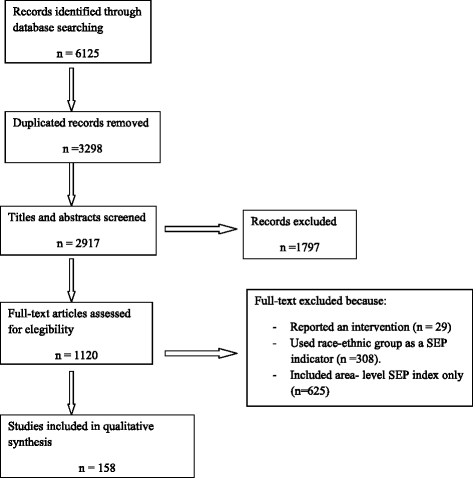Socioeconomic position and childhood-adolescent weight status in rich countries: a systematic review, 1990-2013
- PMID: 26391227
- PMCID: PMC4578240
- DOI: 10.1186/s12887-015-0443-3
Socioeconomic position and childhood-adolescent weight status in rich countries: a systematic review, 1990-2013
Abstract
Background: Childhood obesity is a major problem in rich countries due to its high prevalence and its harmful health consequences. An exploratory analysis conducted in the PubMed database highlighted that the number of papers published on the relationship between socioeconomic position (SEP) and childhood-adolescent weight status had risen substantially with respect to an earlier review which had covered the period 1990-2005.
Methods: To describe the findings on the relationship between SEP and childhood-adolescent weight status in papers published in rich countries from 1990 through 2013, studies were identified in the following databases: PubMed; Web of Knowledge (WOK); PsycINFO; Global Health; and Embase. We included observational studies from the 27 richest OECD countries, which covered study populations aged 0 to 21 years, and used parental education, income and/or occupation as family SEP indicators. A total of 158 papers met the inclusion criteria and reported 134 bivariable and 90 multivariable analyses.
Results: Examination of the results yielded by the bivariable analyses showed that 60.4% of studies found an inverse relationship, 18.7% of studies did not found relationship, and 20.9% of studies found a relationship that varied depending on another variable, such as age, sex or ethnic group; the corresponding percentages in the multivariable analyses were 51.1, 20.0 and 27.8%, respectively. Furthermore, 1.1% found a positive relationship.
Conclusion: The relationship between SEP and childhood-adolescent weight status in rich countries is predominantly inverse and the positive relationship almost has disappeared. The SEP indicator that yields the highest proportion of inverse relationships is parents' education. The proportion of inverse relationships is higher when the weight status is reported by parents instead using objective measurements.
References
-
- World Health Organization . Obesity: preventing and managing the global epidemic. Geneva: WHO; 2000. - PubMed
Publication types
MeSH terms
LinkOut - more resources
Full Text Sources
Other Literature Sources
Medical
Miscellaneous


